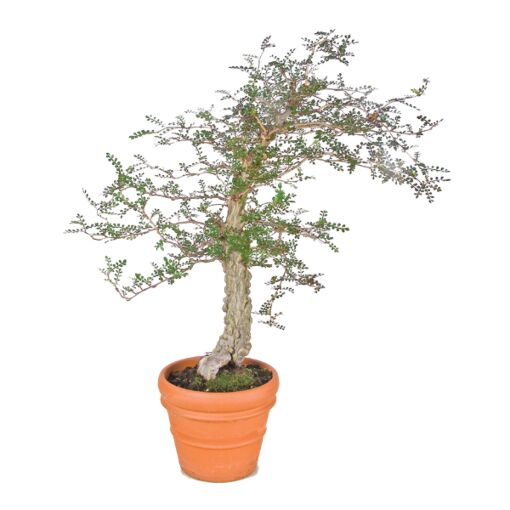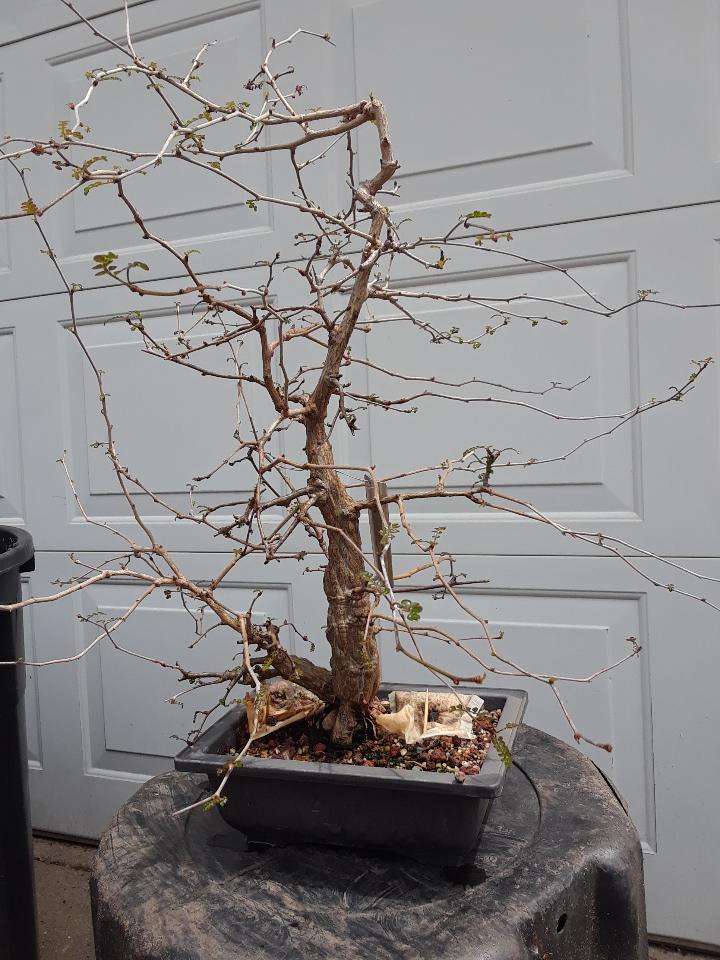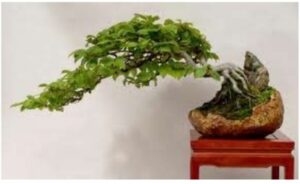
ELEPHANT TREE
This month I have chosen the Elephant Tree. There are 4 species that are commonly referred to as the elephant tree because of their swollen stems/trunks
Boswellia papyrifera, native to northeastern Africa
Bursera microphylla, native to the southwestern United States and northern Mexico
Pachycormus discolor, native to Baja California
Operculicarya decaryi, are native to Madagascar. Specifically the Toliara Province of southwest Madagascar. This is the one we will be reviewing as it is used the most for bonsai. Also called Jabily, it is a succulent deciduous evergreen tree in the Sumac (Anacardiaceae) Family. It is called anilu Elephant Tree because of its shiny gray bark and gnarled, thickened, bumpy trunk known as a caudex. With tiny leaves, they are ideally suited for bonsai. The small, pinnate leaves are drought deciduous and emerge following rains. In late winter, the mature trees bloom with clusters of six or so tiny, dark-red flowers at the end of short branches. A closer examination will show the odd-pinnate alternating leaves turning a slight tinge of red as the weather gets cooler. In Summer, the leaves can vary from green in part shade to a copper-bronze color in full sun.
INTERESTING FACT: Elephant trees were so rare that for many years skeptics refused to acknowledge their existence. Operculicarya decaryi was first described in 1944 by Joseph Marie Henry Alfred Perrier de la Bathie (how is that for a name), a French botanist specializing in the plants of Madagascar. The actual name honors the plant collector Raymond Decary.
STYLING: The natural tendency of this species is to be very upright and straight, and since its trunk is one of the unique features of this particular tree, it is good to allow the tree to grow a straight trunk up to your preferred height. Afterward, you can start pruning to begin shaping its final form.
PLACEMENT: Elephant trees prefer partial to full sun, don’t let them get too hot or dry out during their growing season. Filtered light is best. Half the day direct sunlight, half the day partial sunlight is perfect. They do best when the temperature stays above 60F. But when night temps stay around 40F, it must be brought indoors. It does not tolerate freezing conditions.
WATERING: Elephant trees can go long periods without water. They have evolved to withstand drought. Even though it is drought tolerant, elephant trees need to be watered regularly during the warmer months when they are growing. It has an enlarged caudiciform trunk that stores water. You can allow it to get drier as it goes dormant in the winter. It will then require very slight watering. You can gradually increase watering towards the summertime. But remember, excess watering will put your tree at a disadvantage with a high-risk factor of developing the dreaded root-rot disease.
FERTILIZING: Fertilize your Operculicarya decaryi once or twice a month when the plant is in its active growth stage. Do not fertilize during the cold/wintery season when dormant. Instead, reserve fertilizers for spring through fall when temperatures are 60F or higher. These trees are light to medium feeders but will appreciate a balanced, low-level fertilizer during this time.
PRUNING AND WIRING: Elephant trees don’t need a lot of pruning. They are small trees that grow pretty slowly. Trimming is mainly done to control its shape and size. It buds back well, and even old bark has dormant buds that can sprout – so basically, once the tree is in active growth, you can cut it anywhere your artistic vision requires it to be cut. Young branches can be wired and stay flexible for a few years. Young branches will spring back for a few seasons, so you need to wire, remove the wire when it begins to cut in, then wire again until it holds its shape. Old wood is brittle and difficult to bend without breaking and will resist taking on a new form. For these trees, everything starts with their main trunk, which will grow upwards until it reaches a certain height. After that, it will then begin to branch out sideways. This is when and where you’ll prune to maintain its form, shape, and size. Pruning encourages lateral limb growth and side branching. You’ll want to prune your elephant tree if it becomes leggy, which can happen if it’s not getting enough light. Thus, it will stretch towards where the light is, becoming longer and taller. Snip any twiggy or interlocking stems to keep the plant neat.
REPOTTING: Like most other succulents, the elephant tree needs a soil structure with substantial aeration and excellent drainage properties. Therefore a suitable bonsai substrate or Cactus soil mix is perfect for this tree. Avoid the temptation to overpot, that is, to put them into a pot that is too big. A small pot that confines the roots will make them grow with thicker trunks. If you repot them, use a container just an inch larger about every three years. And after a point, they will be happy to live in an 8-inch pot for the rest of their lives.
PESTS AND DISEASES: It is relatively pest and disease-free. Just watch out for root rot.
PROPAGATION: It is pretty easy to propagate via both seeds or cuttings. This tree is dioecious, which means that trees are either male or female blooming. You must have a male and female tree to produce seed. Growing them from seed allows them to develop better roots.
Seedlings will inherit traits passed on from their parents, so by choosing parent trees with the characteristics you like, such as an extreme bumpy trunk, the seedlings will carry on these traits. It also makes them more interesting to look at since their trunks will have more bumps and lumps. The seeds are roughly a quarter of an inch in size. You can quickly know when it is ripe because it will turn a distinct dark purple color. To do so, collect the seeds. Put them in warm water for 24 hours to soak.
After soaking, place them in moist bonsai soil. Since they’re slow growers, you’ll need to practice patience which means about six months of waiting.
Propagating from cuttings is also easy. Take cuttings, and leave them on the bench to dry for at least a week. The cut end will seal itself, then pot them up, and they should root. Or take a few pieces of its tuberous root.
You can then place them in water or a soil mixture. After three weeks, you should start seeing small leaves begin to sprout. Easy, peasy…..
Written by Charlotte Field
References: Succulent City, Botanic Wonders, Leo Schordje, Wikimedia, Paul Barbano
Below is a recent photo of the author’s very own Operculicarya decaryi. “Notice it is getting tiny leaves because it is out of dormancy now and has sun and rain. It got leggy over the winter. Now it will get snipped and trimmed”.




